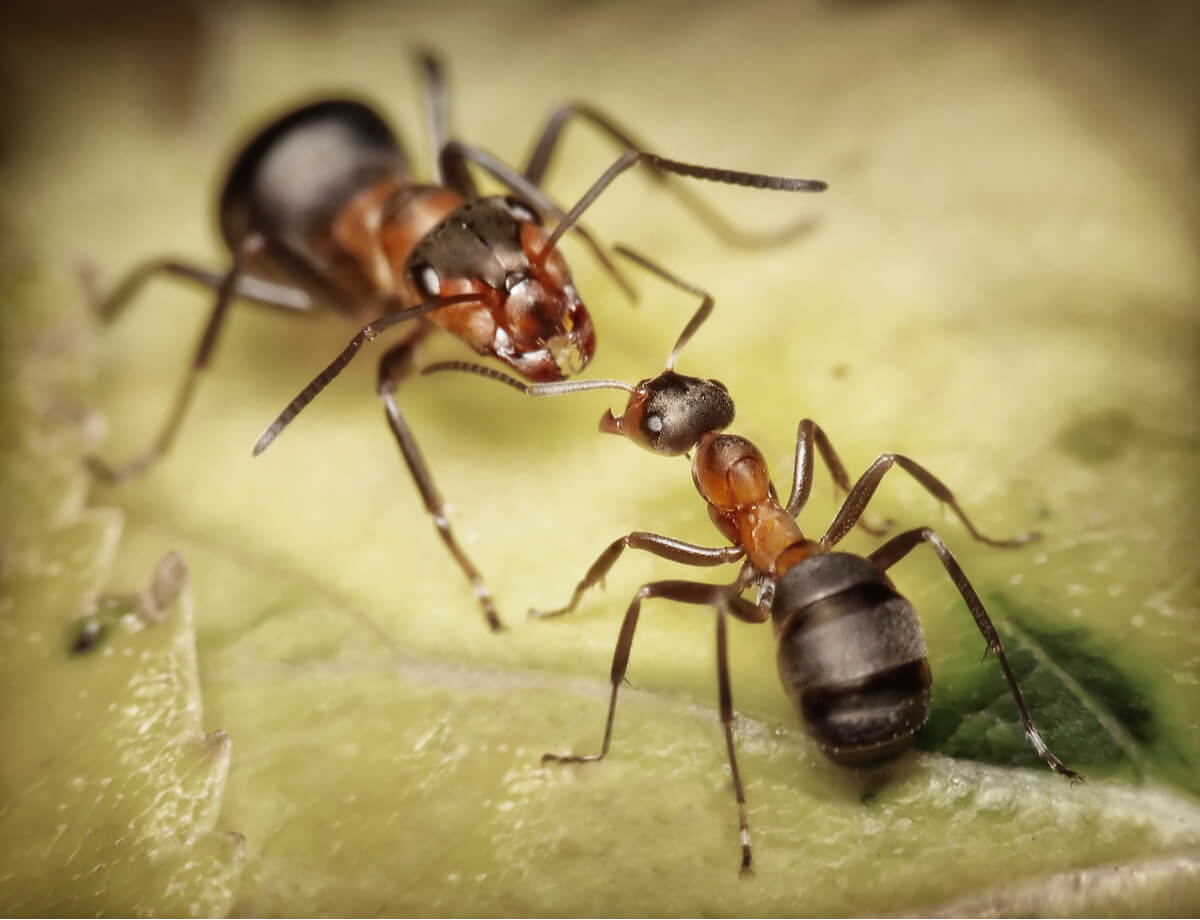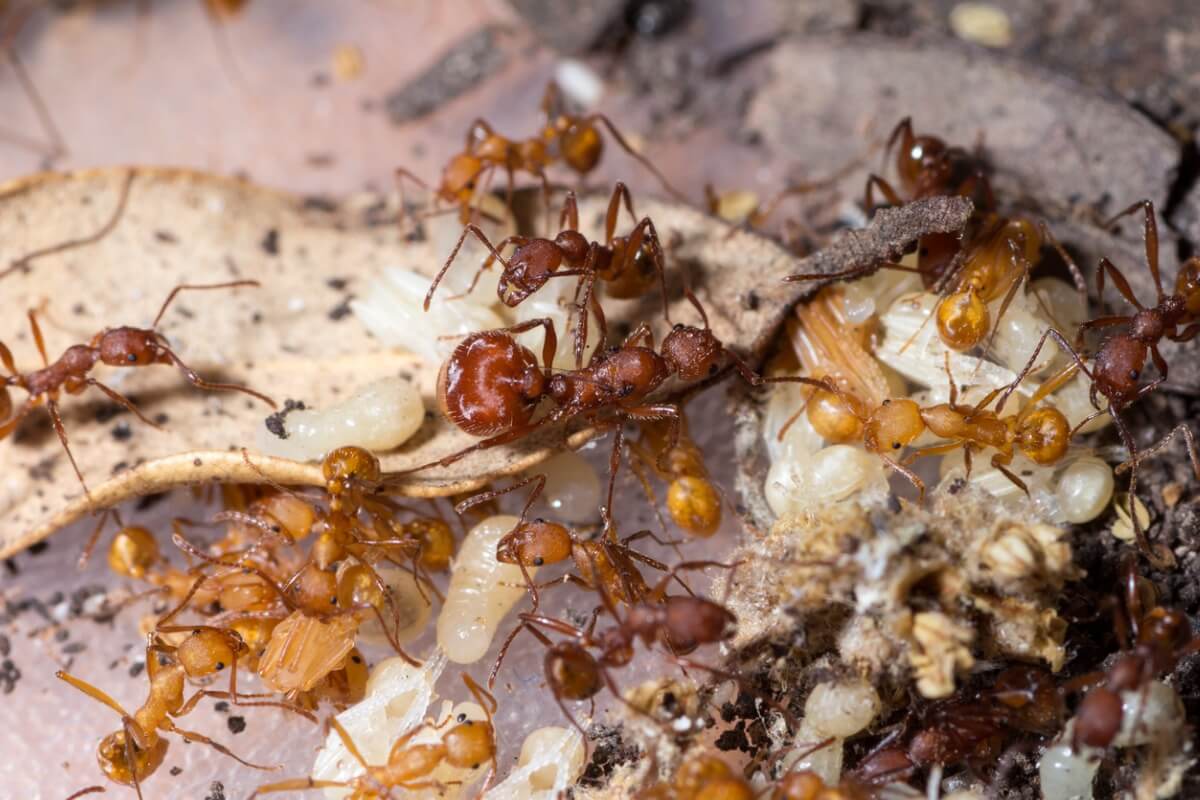Differences Between Queen and Worker Ants

Ants have one of the most complex societies in existence today, as they use a caste system that allows them to work efficiently. Thanks to this, while some are in charge of getting food or protecting the nest, others take care of the queen and expand the galleries. Cooperation between each individual in the colony is essential for its survival. Find out about the differences between queen and worker ants here.
This society is governed by a queen ant, which produces all the workers that usually have obvious physical differences between them. In fact, both are born from fertile eggs, but some become matriarchs and others are only the “servants” that tend the nest. Continue reading this space and discover what makes the members of the anthill so different.
What are the characteristics of each caste?
There are at least 4 different castes within the anthill, although this number can increase depending on the species involved. All of them are produced by the matriarch of the colony (queen) and there are several differences between them. Some characteristics of each of the intra-colony groups are the following:
- Workers: Infertile females that hatch from fertilized eggs. They have different sizes depending on the development process involved. In general, their bodies are more rigid than those of other castes because they need considerable strength to perform their tasks. They’re in charge of caring for the eggs, feeding the queen, expanding the nest, and hunting.
- Queens: (winged or wingless): Fertile females that hatch from fertilized eggs. They’re only produced during the mating season. They’re the largest individuals in the nest, as their bodies are adapted to oviposit constantly.
- Soldiers: Infertile females that hatch from fertilized eggs. They’re very similar to workers, but with a larger body size. Some species have elongated mandibles that serve to respond to aggression. Their main task is to defend the colony from any invader.
- Males (winged or wingless): These come from unfertilized eggs. They have half the normal genetic load(haploid) and their sizes are generally a little smaller than those of the workers. Their only function is to mate with virgin queens so that they can found new anthills. However, they die soon after accomplishing their goal.
The main difference between the males and any of the females is their genetic load. Queens use this strategy because of the way they reproduce, as most species only mate once in their lifetime. Therefore, they store sperm inside their bodies and dose it to fertilize their eggs, although they save large quantities by producing males from infertile eggs.

Why are there differences between soldiers and workers?
At first glance, it could be said that soldier ants are just another classification within the worker caste. However, it seems that this isn’t as simple as was once believed. According to an article published in the Specialized Journal of Chemical-Biological Sciences, the size of the individuals also plays an important role in the division of tasks.
The size difference between each caste of ants is known as polymorphism, which is thought to be one of the many adaptations of the Formicidae. In fact, this mechanism is programmed into the genes of the species in order to create individuals with characteristics suitable for each task.
Thus, the soldiers grow larger and develop better jaws because they’ll be calld to defend the anthill.
Why are there differences between queen and worker ants?
Both queen and worker ants have notable physical differences as adults. However, the question may remain: why, if they both hatch from a fertilized egg, do they have so many different characteristics at birth? According to an article published in Current Biology, this happens because each egg is stimulated differently during rearing.
In other words, future queens have a preferential diet, and are exposed to pheromones, temperatures, and other chemical components that determine their transformation into a matriarch. On the other side of the coin, the workers have only the basic care given to all members of the nest.
Incredible as it sounds, this difference in rearing triggers an epigenetic process that “switches on” certain genes in the queens. This means that all females have the latent ability to become queens. However, only those that undergo preferential care are able to “activate” these characteristics and become one.

Evolutionary adaptation
This epigenetic process is yet another of the ant’s adaptations, as it allows it to produce castes with major differences – such as the queen and the worker – from the same genome. Thanks to this, the species doesn’t only save time, but is able to create a complex and diversified society with great survival capabilities.
Queens with the appearance of workers (ergatoids)
Although in most species the differences between queens and workers are evident, in some there are exceptions that can cause confusion. This is the case of queens with the appearance of workers. These are also called eegatoids, and will replace the matriarchs if they die, in order to keep the nest active.
The ergatoids have great functionality within the colony, as they’re quite versatile and save resources for the nest. This adaptation of some species, such as those of the genus Mystrium, wouldn’t be possible if queens and workers didn’t have the same genome.
Workers with queen capabilities: the gamergates
The evolutionary process of ants is complex and quite slow. In fact, this is shown by the fact that some workers still maintain their reproductive capacity. These individuals are known as gamergates and are present in “ancestral” species, meaning that they possess ancient characteristics.
One example of this is the genus Harpegnathos whose queen ant doesn’t differ greatly from the worker ant. In fact, the other females still have the ability to reproduce, although they don’t do so by their matriarch’s “command”. Only if their queen dies, will the workers have the possibility to start laying eggs and replace her.
As you can see, the simple fact of maintaining the same genome for all organisms gives ants great flexibility. Although these differences seem simple and meaningless, they’re actually very complex and provide evolutionary advantages that the queen and worker ants take advantage of for their species. They may be one of the smallest animals in existence, but they’re capable of incredible things.
All cited sources were thoroughly reviewed by our team to ensure their quality, reliability, currency, and validity. The bibliography of this article was considered reliable and of academic or scientific accuracy.
- Peeters, C. P. (1991). Ergatoid queens and intercastes in ants: two distinct adult forms which look morphologically intermediate between workers and winged queens. Insectes Sociaux, 38(1), 1-15.
- Heinze, J. (1998). Intercastes, intermorphs, and ergatoid queens: who is who in ant reproduction?. Insectes Sociaux, 45(2), 113-124.
- Molet, M., Fisher, B. L., Ito, F., & Peeters, C. (2009). Shift from independent to dependent colony foundation and evolution of ‘multi-purpose’ergatoid queens in Mystrium ants (subfamily Amblyoponinae). Biological journal of the Linnean Society, 98(1), 198-207.
- López-Riquelme, G. O., & Ramón, F. (2010). El mundo feliz de las hormigas. Tip Revista Especializada en Ciencias Químico-Biológicas, 13(1), 35-48.
- Chittka, A., Wurm, Y., & Chittka, L. (2012). Epigenetics: the making of ant castes. Current Biology, 22(19), R835-R838.
This text is provided for informational purposes only and does not replace consultation with a professional. If in doubt, consult your specialist.